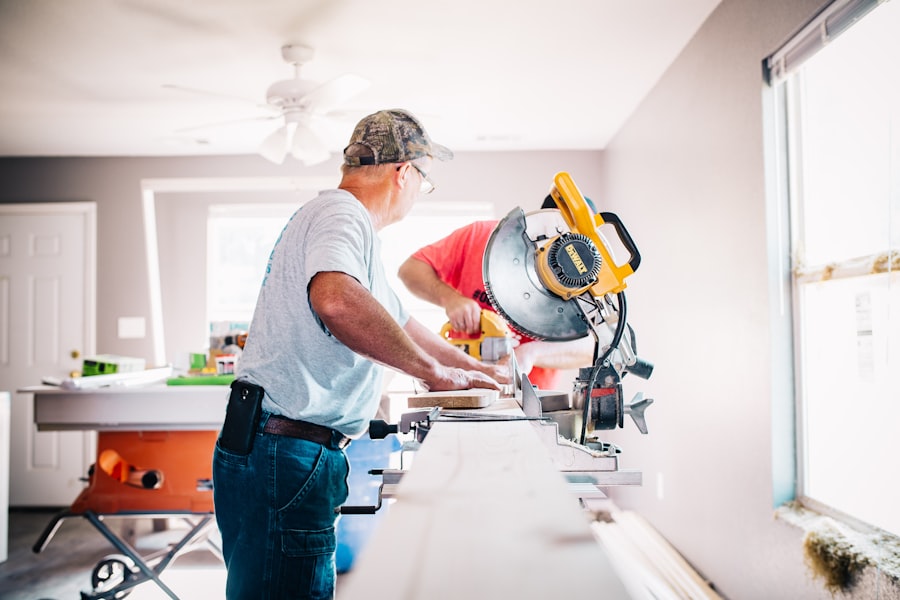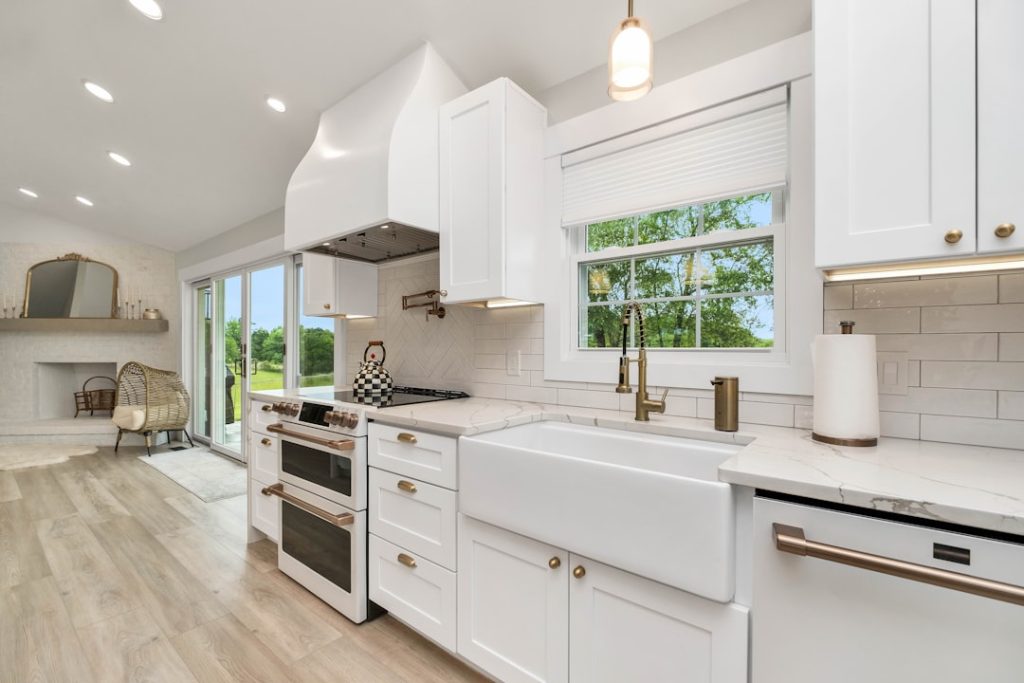Embarking on a kitchen and bathroom remodel is an exciting yet intricate endeavor that requires careful planning. The first step in this journey is to define your goals and objectives. Are you looking to create a more functional space, enhance aesthetics, or increase your home’s value?
Understanding your primary motivations will guide every decision you make throughout the remodeling process. For instance, if your goal is to improve functionality, you might prioritize layout changes, such as relocating appliances or adding storage solutions. Conversely, if aesthetics are your main concern, you may focus on selecting stylish finishes and fixtures that reflect your personal taste.
Once you have established your goals, it’s essential to assess the current state of your kitchen and bathroom. Take a thorough inventory of what works and what doesn’t. Consider factors such as the flow of movement, the amount of natural light, and the overall ambiance of the space.
This evaluation will help you identify specific areas that require improvement. For example, if your kitchen feels cramped, you might explore options for an open-concept design or the addition of an island to facilitate better traffic flow. In the bathroom, if storage is lacking, you may want to consider built-in shelving or cabinetry that maximizes vertical space.
By conducting a comprehensive assessment, you can create a clear vision for your remodel that aligns with your goals.
Key Takeaways
- Careful planning is essential for a successful kitchen and bathroom remodel.
- Establishing a clear budget helps manage costs and avoid overspending.
- Selecting quality materials and fixtures impacts durability and style.
- Hiring a reputable contractor ensures professional workmanship and project efficiency.
- Incorporating sustainable features and current design trends can boost home value and functionality.
Budgeting for Your Remodeling Project
Budgeting is a critical component of any remodeling project, as it sets the parameters for what is feasible within your financial constraints. Begin by determining a realistic budget based on your goals and the scope of work required. It’s advisable to research average costs for kitchen and bathroom remodels in your area to gain a better understanding of what to expect.
For instance, a minor kitchen remodel might range from $10,000 to $15,000, while a full-scale renovation could easily exceed $50,000 depending on the materials and labor involved. Similarly, bathroom remodels can vary widely, with average costs ranging from $5,000 for a simple update to over $25,000 for a luxurious overhaul. Once you have established a budget range, it’s crucial to allocate funds appropriately across various categories such as materials, labor, permits, and unexpected expenses.
A common rule of thumb is to set aside 10-20% of your total budget for contingencies. This buffer will help you manage unforeseen costs that may arise during the remodeling process, such as discovering plumbing issues or structural problems that need addressing. Additionally, consider prioritizing your spending based on your goals; for example, if high-quality cabinetry is essential to your vision, allocate more funds toward that aspect while being more conservative with other elements like decorative hardware.
Choosing the Right Materials and Fixtures

Selecting the right materials and fixtures is pivotal in achieving both functionality and aesthetic appeal in your kitchen and bathroom remodel. The choices you make will not only influence the overall look of the space but also its durability and maintenance requirements. When it comes to countertops, for instance, granite and quartz are popular options due to their resilience and timeless beauty.
Granite offers unique patterns and colors but requires periodic sealing to maintain its integrity. On the other hand, quartz is engineered for consistency and is non-porous, making it easier to clean and maintain. In addition to countertops, cabinetry plays a significant role in both function and style.
Solid wood cabinets are often favored for their durability and classic appeal; however, they can be costly. Alternatively, laminate or MDF (medium-density fiberboard) cabinets can provide a budget-friendly option while still offering a variety of finishes and styles. When selecting fixtures such as faucets and sinks, consider both form and function.
A high-arc faucet can enhance usability while adding a modern touch to your kitchen or bathroom. Additionally, pay attention to water efficiency ratings when choosing fixtures; opting for low-flow faucets and showerheads can contribute to long-term savings on water bills.
Hiring a Professional Contractor
| Metric | Description | Typical Range | Importance |
|---|---|---|---|
| Cost Estimate Accuracy | How close the contractor’s initial estimate is to the final cost | ±5% to ±15% | High |
| Project Completion Time | Duration from project start to finish | 1 week to 6 months (depending on project size) | High |
| License and Insurance Verification | Confirmation that contractor holds valid licenses and insurance | Required by law in most regions | Critical |
| Customer Satisfaction Rate | Percentage of clients satisfied with contractor’s work | 80% to 95% | High |
| Warranty Period | Length of time contractor guarantees their work | 1 year to 5 years | Medium |
| Change Order Frequency | Number of changes requested after project start | 0 to 3 per project | Medium |
| Communication Responsiveness | Average response time to client inquiries | Within 24 to 48 hours | High |
While some homeowners may consider tackling a remodel as a DIY project, hiring a professional contractor can significantly streamline the process and ensure high-quality results. A skilled contractor brings expertise in project management, design considerations, and local building codes that can be invaluable during a remodel. When searching for a contractor, it’s essential to conduct thorough research by seeking recommendations from friends or family and reading online reviews.
Interview multiple candidates to gauge their experience and approach to projects similar to yours. Once you have narrowed down your options, request detailed estimates from each contractor that outline labor costs, material expenses, and timelines. This transparency will help you make an informed decision based on both budgetary constraints and the contractor’s ability to meet your expectations.
Additionally, ensure that the contractor is licensed and insured; this protects you from potential liabilities during the remodeling process. Establishing clear communication from the outset is also crucial; discuss your vision in detail and set regular check-ins throughout the project to address any concerns or adjustments that may arise.
Maximizing Space and Functionality
Maximizing space and functionality is particularly important in kitchens and bathrooms, where efficient layouts can significantly enhance usability. In kitchens, consider implementing an open-concept design that removes barriers between cooking and living areas. This approach not only creates a more spacious feel but also encourages social interaction during meal preparation.
Incorporating multi-functional furniture such as an island with built-in storage can further optimize space while providing additional seating options. In bathrooms, clever design choices can make even the smallest spaces feel more expansive. For instance, wall-mounted vanities create an illusion of more floor space while providing essential storage solutions.
Additionally, using large-format tiles can minimize grout lines and create a seamless look that enhances the perception of space. Consider installing mirrors strategically to reflect light and create depth; a well-placed mirror can make a compact bathroom feel much larger than it actually is. By focusing on maximizing space through thoughtful design choices, you can create functional areas that cater to your lifestyle needs.
Adding Value to Your Home through Remodeling

Remodeling your kitchen and bathroom can significantly increase your home’s value when done thoughtfully. These two areas are often considered focal points for potential buyers; therefore, investing in quality upgrades can yield substantial returns when it comes time to sell. According to various real estate studies, kitchen remodels typically recoup about 60-80% of their costs upon resale, while bathroom renovations can return approximately 50-70%.
This makes them some of the most lucrative home improvement projects available. To ensure that your remodel adds value rather than detracts from it, focus on timeless designs that appeal to a broad audience rather than overly personalized choices that may alienate potential buyers. Neutral color palettes tend to resonate well with buyers; consider shades of white, gray, or beige for walls and cabinetry while adding pops of color through accessories that can be easily changed out.
Additionally, investing in high-quality materials will not only enhance the aesthetic appeal but also signal to buyers that they are purchasing a well-maintained home.
Incorporating Sustainable and Energy-Efficient Features
In today’s environmentally conscious society, incorporating sustainable and energy-efficient features into your kitchen and bathroom remodel is not only beneficial for the planet but also appealing to many homebuyers. Start by selecting energy-efficient appliances that bear the ENERGY STAR label; these appliances consume less energy while maintaining performance standards. For example, modern dishwashers use significantly less water than older models while still delivering excellent cleaning results.
In addition to appliances, consider using sustainable materials such as bamboo flooring or recycled glass countertops. Bamboo is a rapidly renewable resource that offers durability and aesthetic appeal while minimizing environmental impact. Furthermore, installing low-flow toilets and faucets can drastically reduce water consumption without sacrificing performance.
By integrating these eco-friendly features into your remodel, you not only contribute positively to the environment but also position your home as an attractive option for buyers who prioritize sustainability.
The Latest Trends in Kitchen and Bathroom Design
Staying abreast of the latest trends in kitchen and bathroom design can inspire creativity in your remodeling project while ensuring that your spaces remain contemporary and appealing. One notable trend is the rise of smart technology integration in both kitchens and bathrooms. Smart appliances allow homeowners to control functions remotely via smartphones or voice commands; for instance, smart refrigerators can help manage grocery lists while smart faucets can dispense precise amounts of water.
Another trend gaining traction is the use of bold colors and patterns in cabinetry and tiles. While white kitchens have long been popular for their timelessness, many homeowners are now opting for deep blues or greens that add character and warmth to the space. In bathrooms, patterned tiles are being used as statement pieces in showers or backsplashes to create visual interest without overwhelming the overall design.
Additionally, open shelving continues to be favored over traditional upper cabinets in kitchens; this trend not only provides easy access to frequently used items but also allows homeowners to showcase decorative dishware or plants. By embracing these trends while remaining true to your personal style and functional needs, you can create kitchen and bathroom spaces that are not only beautiful but also reflective of current design sensibilities.




